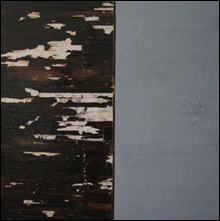Compelling new work by Neal T. Walsh and William Schaff
By GREG COOK | April 15, 2008

POWERFUL: Walsh’s The Clearing. |
Providence artist Neal Walsh’s great new abstract paintings bring to mind peeling paint, rust, and cracking plaster in old mills or houses, maybe the wall in the hall of an apartment building. On view at 5 Traverse gallery — along with work by Warren’s William Schaff — they embody the romance of ruins, capturing a particularly Providence love of old buildings and their majestic rot. But they also reach toward humanity’s ancient awe of ruins from Egypt to Greece to Mexico — to Edward Hopper’s sagging Victorian homes and tired city streets.
Walsh, the gallery director at AS220, corrals these textures and moods into squares and rectangles and grids painted on canvas and plywood. Whitebreakers (2006) looks like an old white plaster wall scratched and weathered until old layers of red, green, and cream paint underneath show through. The left two-thirds of Without Notice (2008) looks as if rusty water has puddled atop some crusty crud — actually bits of pigment and gold leaf. A stained and speckled square of rumpled newspaper fills the upper right corner. Below it, Walsh painted a rectangle of yellow ochre with a crisp left edge where it overlaps the brown. Notice his careful attention to edges. Sometimes he doesn’t quite paint to the edge, so things raggedly trail off, revealing the history of his process in overlapping layers of paint. Sometimes he paints a hard stripe along the edge that asserts itself like the period at the end of a sentence.
These are slow-burn, elegantly composed, meditative abstractions by an artist clearly in full command of his craft. My only hesitation is, could they be too tasteful? Walsh’s style is rooted in American abstract painting of the ‘40s to ’60s. He tells me that one inspiration is Matt McCormick’s 2001 documentary film The Subconscious Art of Graffiti Removal, which half-jokingly compares the patchwork shapes of painted-over graffiti to Mark Rothko paintings. Walsh’s stripes recall Barnett Newman and Richard Diebenkorn. (For Walsh, the lines and sections symbolize the transitions and divisions between one part of your life and the next.) A grid brings to mind Agnes Martin.
 Related
Related:
Fever dreams, Goodbye to Gallery Agniel/Martina & Co., Worth another look, More 
- Fever dreams
Written in the tradition of the historieta — pulp comics sold in the tens of millions monthly from every Mexican newsstand and bodega — Dead in Desemboque comes across like a dying gringo’s border desert mirage.
- Goodbye to Gallery Agniel/Martina & Co.
In the fall of 2004, gallerist Sara Agniel and jewelry designer Martina Windels joined forces, moving Gallery Agniel into Martina & Company’s storefront at 120 North Main St. in Providence.
- Worth another look
In 2008, real estate and jobs dominated local art news.
- Philosophy students
Austrian artist Erwin Wurm loves playing the philosopher.
- Affirmative action
YES Gallery is located in a gorgeous green wood-frame 1883 building on a quaint strip of boutiques and restaurants that runs parallel to the Warren River.
- The folk and the fine
Here in Massachusetts, our old ways tend to reside in ethnic islands and pockets. They may be famous on their street or in their neighborhood or town, but they’re often unheard of outside it.
- New galleries sprout on Federal Hill
A mini gallery district is sprouting on Providence’s Federal Hill, with three galleries moving onto Atwells Avenue, all within a few blocks of Gallery Z, which has been there since 2004.
- Girls, girls, girls
Around 1600, after a century of civil wars, Japan settled into an era of relative peace under the samurai warriors of Edo (present-day Tokyo).
- Slideshow: ''The Beast In Me - Johnny Cash''
Artwork from "The Beast In Me—Johnny Cash: Art Influenced by the Struggle of a Man" at the Nave Gallery
- Natural selections
The gorilla is a black blur, out of nowhere, barreling into the cage door — clang! — and then zooming off through the fake rocks and trees.
- ‘Beings’ there
In the front window of Stairwell Gallery sit Leif Goldberg’s life-sized coyote-man marionette and some of Erin Rosenthal’s Garbage Dancers .
- Less

 Topics
Topics:
Museum And Gallery
, Painting, Visual Arts, Edward Hopper, More  , Painting, Visual Arts, Edward Hopper, Barnett Newman, Mark Rothko, Neal Walsh, William Schaff, Richard Diebenkorn, Agnes Martin, Matt McCormick, Less
, Painting, Visual Arts, Edward Hopper, Barnett Newman, Mark Rothko, Neal Walsh, William Schaff, Richard Diebenkorn, Agnes Martin, Matt McCormick, Less 